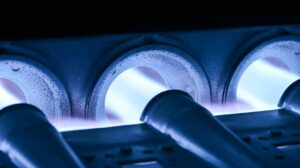
The short answer to this question is, “yes!”
But we don’t expect you to take that at face value. After all, it’s such a small component, how important could it be? Well, if we’re talking about the heat exchanger in your gas-powered furnace, pretty darn important!
Look, we’re not here to panic you or scare you into thinking that gas-powered furnaces are inherently dangerous—they’re not. But when you ignore a problem as serious as this, they certainly can be. Just like any other appliance that creates combustion gasses, a furnace has the potential to create health hazards if the system isn’t properly maintained. Treat your gas furnace well and you’ll have little to worry about.
Cracked heat exchangers are a problem usually isolated to aging furnaces—that is, any furnace over 15 years old. For this reason, we typically recommend system replacement once your furnace has reached this age. Read on as we uncover why you don’t want a cracked heat exchanger.
First, What Is a Heat Exchanger?
As you may have surmised from the name of this component, it’s responsible for exchanging heat—in this case from the furnace jets to the air that goes through your ventilation system.
The combustion gasses that go into the heat exchanger from the jets cannot come into direct contact with the air, otherwise unhealthy fumes will wind up going into your home. The heat exchanger, when your furnace is operating correctly, contains these gasses as the heat raises the temperature of the metal casing. As the air from the blower passes around the heat exchangers, heat transfers to the air.
Essentially, heat exchangers are what enable your furnace to actually work as a heater.
The Problem with a Cracked Heat Exchanger
A cracked heat exchanger is a problem because, as we alluded to above, it allows exhaust fumes to leak into your indoor air. The most toxic of these gasses? Carbon monoxide, or CO. CO poisoning leads to hundreds of fatalities and illnesses each year in the U.S.
Your furnace typically sends all fumes out of a flue into the outdoors, but a crack in the heat exchanger will allow some gasses to leak out.
So what causes this? Well the most likely culprit is corrosion. The reaction between the combustion gas and metal throughout the years can create a weakening of the metal. This is why it’s something to definitely watch out for in an aging furnace. Even a small crack is a problem, since it will stretch bigger as the heat exchanger turns hot and expands.
“How Do I Know If I Have a Cracked Heat Exchanger?”
Have you noticed a clicking noise from the furnace after the blower shuts off? If so, this could very well be a sign of a cracked heat exchanger, with the sound originating from the metal contracting as the heat exchanger cools. Another sign that requires immediate attention is if your CO detectors go off.
Contact Kool Breeze of Northwest Florida, Inc. for professional heating services in Navarre!
